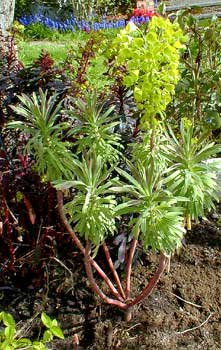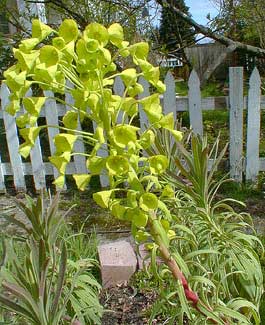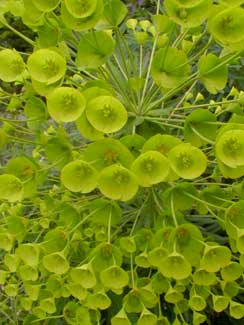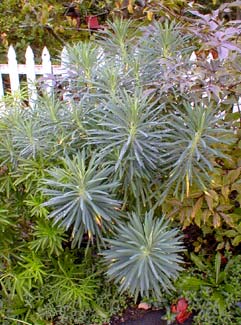
'Lambrook Gold'
Large Mediteranian Spurge;
aka Bush Spurge, or Milkweed;
aka Frog Spawn Bush
"Ay, ay, my brother fool, the king of fools!
Conceits himself as God that he can make
Figs out of thistles, silk from bristles, milk
From burning spurge, honey from hornet-combs,
And men from beasts--Long live the king of fools!"
-Alfred Lord Tennyson
(1809-1892)
 Euphorbia characias wulfenii is a large Eurasian spurge that grows three or four feet in height, on thick succulent upright limbs that can form a very broad clump.
Euphorbia characias wulfenii is a large Eurasian spurge that grows three or four feet in height, on thick succulent upright limbs that can form a very broad clump.The tall heads of little chartreuse trumpet-flowers range toward a purer yellow on 'Lambrook Gold,' in contrast to five-inch-long slender grey-green leaves.
In full sun it blooms at the tail-end of winter (late March on Puget Sound) & through much of spring. The first three photos were taken in April, the first in early April 2003 while it was still growing underneath the Purple-leaf Japanese Maple, the second & third photos from April 2004 & 2005 respectively snapped after it was transplanted to a roadside xeriscape garden where it gets much less water & much more sun, to its delight.
 Although it can be strongly evergreen through winter, it is necessary to cut back each stalk when it is finished blooming in each stalk's second year. The shoots are biennial so one must be careful to cut back only second year branches.
Although it can be strongly evergreen through winter, it is necessary to cut back each stalk when it is finished blooming in each stalk's second year. The shoots are biennial so one must be careful to cut back only second year branches.The pruning of the old stalks should be in June. Almost as soon as they're removed, new shoots appear. If left unpruned the old stems last into winter, but it's not worth it as the overall clump will not refresh itself so pleasantly if the two-year-old stalks are kept for a third year.
The fourth photo shows first-year branches that have not yet flowered. The photo was shot at the end of October (2004) & shows how it will look throughout autumn & winter.
 The clump itself is not longlived, but should last five or six years to a decade if kept in ideal conditions of dry soil. If caught before they go into decline, a section of the eventually enormous clump can be dug out to replant for a revitalized specimen.
The clump itself is not longlived, but should last five or six years to a decade if kept in ideal conditions of dry soil. If caught before they go into decline, a section of the eventually enormous clump can be dug out to replant for a revitalized specimen.Older plants otherwise become decreasingly hardy until finally one winter will prove either too cold or too wet, & it dies. Here in the rainy northwest it requires almost no watering beyond rainfall, & must be planted in very well draining soil in order to make it through our wet winters.
This euophorbia has a long gardening history. The species name is derived from Xaraxias which is what Dioscorides called it in the first century C.E. It was also known to Theophrastus in the second century B.C.E.
The cultivated form 'Lambrook's Gold' was developed by the late Margery Fish at East Lambrook Manor, Somerset. Her brighter yellow variety has become the most commonly offered of many cultivated forms. It is a recipient of the Award of Garden Merit from the Royal Botonical Society.
It will all but invariably self-seed, just so long as conditions are not too wet for its own seedlings to survive. The second after it was moved to the roadside there were two young plants that appeared nearby, one of which I dug up to give to a friend, the other I'm leaving in its self-selected location. So even if in some future year the first clump begins to decline from old age, it looks like there'll always be new ones cropping up as replacements. It does not grow totally true from seeds, however, & these variable plants are traditionally called by the cultivation name 'Margery Fish.'